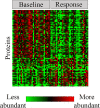Assessment of the Utility of the Oral Fluid and Plasma Proteomes for Hydrocodone Exposure
- PMID: 31677050
- PMCID: PMC6942069
- DOI: 10.1007/s13181-019-00731-0
Assessment of the Utility of the Oral Fluid and Plasma Proteomes for Hydrocodone Exposure
Abstract
Introduction: Non-medical use and abuse of prescription opioids is a growing problem in both the civilian and military communities, with minimal technologies for detecting hydrocodone use. This study explored the proteomic changes that occur in the oral fluid and blood plasma following controlled hydrocodone administration in 20 subjects.
Methods: The global proteomic profile was determined for samples taken at four time points per subject: pre-exposure and 4, 6, or 168 hours post-exposure. The oral fluid samples analyzed herein provided greater differentiation between baseline and response time points than was observed with blood plasma, at least partially due to significant person-to-person relative variability in the plasma proteome.
Results: A total of 399 proteins were identified from oral fluid samples, and the abundance of 118 of those proteins was determined to be significantly different upon metabolism of hydrocodone (4 and 6 hour time points) as compared to baseline levels in the oral fluid (pre-dose and 168 hours).
Conclusions: We present an assessment of the oral fluid and plasma proteome following hydrocodone administration, which demonstrates the potential of oral fluid as a noninvasive sample that may reveal features of hydrocodone in opioid use, and with additional study, may be useful for other opioids and in settings of misuse.
Keywords: Hydrocodone; Opioid; Oral fluid; Plasma; Proteomics.
Conflict of interest statement
None.
Figures


References
-
- FACT SHEET. President Obama proposes $1.1 billion in new funding to address the prescription opioid abuse and heroin use epidemic [press release] February. 2016;2:2016. - PubMed
Publication types
MeSH terms
Substances
LinkOut - more resources
Full Text Sources
Medical

